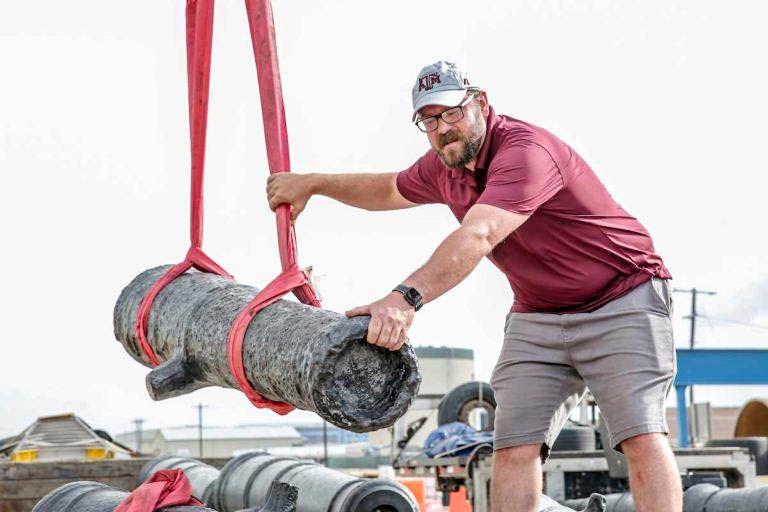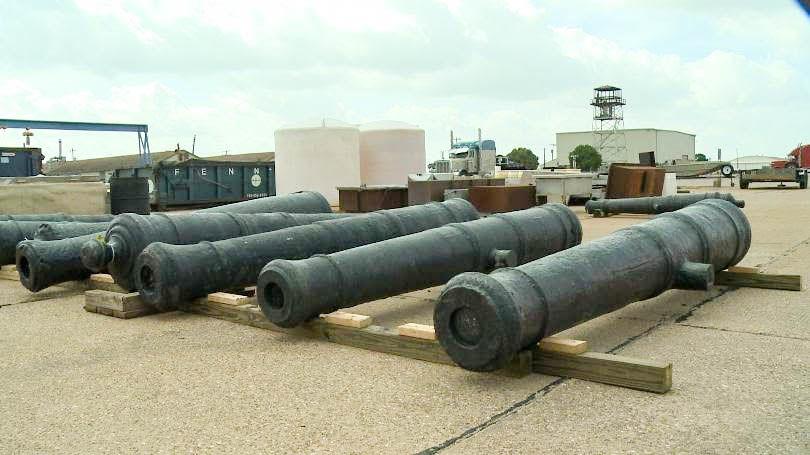The Conservation Research Laboratory (CRL) at Texas A&M University is restoring over 25 cannons in a two-year period at the famous Castillo De San Marcos, located in St. Augustine, Florida. Now a national monument, the Castillo De San Marcos is the oldest masonry fort built in the continental United States.
CRL assistant professor Christopher Dostal helps oversee and conserve all of the projects that come to the lab.
“What we’re dealing with is the corrosion that occurs naturally over the years, where the cannons sit out on the coast and the salt in the air makes them rust,” Dostal said. “It’s just a rough environment for them to be in.”
In June, the first 14 cannons were brought to the new RELLIS Education and Research Campus in Bryan to begin the restoration process, which can take two years. The cannons range in weight from 500 to 7,500 pounds, and originated between 1690 to 1846. Throughout time, the cannons on display at the Castillo De San Marcos have come and gone with wear and tear, but some of the cannons have changed.
“The process is pretty standard for most iron artifacts, what we do we take a hammerhead, or take a whole cannon and we submerge it into a steel vat of sodium hydroxide solution, along with an electrical current that helps remove the corrosion,” Dr. Dostal said. “It’s most definitely a process, but we’ve done well over 40 cannons where we know our timelines and what goes with them.”
The cannons were implemented in the 17th century to help protect the harbor against the pirates or any other intruders coming into the bay. The fort became a U.S. national monument in 1924 and the National Park Service took it over to preserve the structure and everything surrounding it a decade later.
Lab manager at the CRL Jim Jobling helps initiate contracts within the National Parks Service to bring in projects to Texas A&M to help restore.
“A project like this is truly a win-win cooperation between two institutions because we get to teach our students on how to restore within our lab,” Jobling said. “It brings more to light what we do, also the fort gets their history restored as well, everybody wins.”
Jobling helps run the day to day operations of the lab and to help teach the students the practical side of artifact conversation. Jobling has been at Texas A&M since 1985, as he acquired his masters from A&M in 1993 and has been conserving projects since 1996.
The two year project will cost an estimated $458,000. The CRL has worked on over 185 projects since 1996, according to Jobling, and is currently conserving cannons from the Alamo and the CSS Georgia.
“My feeling in projects like these is that I want to preserve our past, therefore our future will be protected,” Jobling said. “History is truly important to me.”
Restoring History
July 23, 2018
0
Donate to The Battalion
$2065
$5000
Contributed
Our Goal
Your donation will support the student journalists of Texas A&M University - College Station. Your contribution will allow us to purchase equipment and cover our annual website hosting costs, in addition to paying freelance staffers for their work, travel costs for coverage and more!
More to Discover











